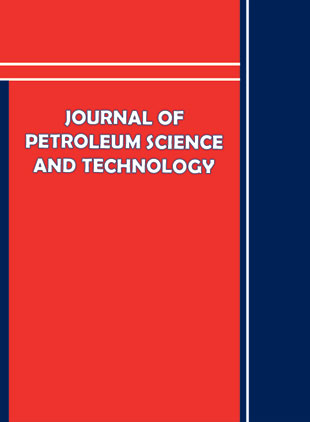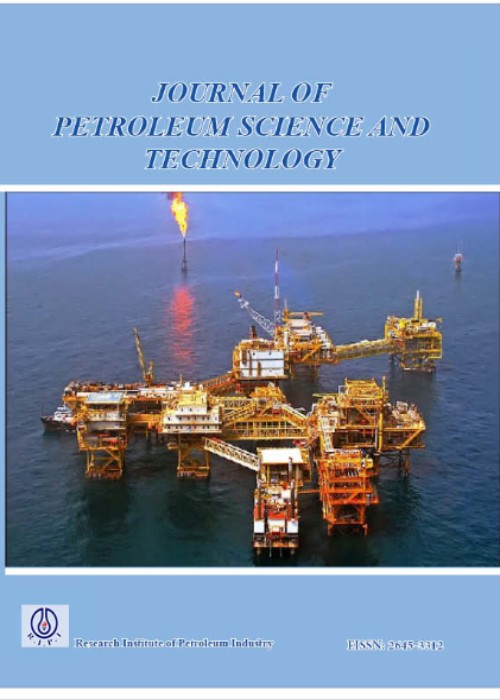فهرست مطالب

Journal of Petroleum Science and Technology
Volume:4 Issue: 1, Winter 2014
- تاریخ انتشار: 1393/01/20
- تعداد عناوین: 8
-
-
Pages 1-19A study of the diagenetic evolution of sandstones from Panyu low-uplift in the Pearl River Mouth Basin was carried out to unravel the controls on shelf margin sandstone reservoir quality. The reservoir rocks, Oligocene volcanic clastic sandstones of the Zhuhai Formation, have a burial depth of 2765 to 3440 m. 70 samples were studied using the granulometric analyses, X-ray diffraction (XRD) analyses, porosity and permeability measurements, SEM observations, and mercury porosimetry measurements. The sandstones are fine- to medium-grained lithic sub-arkose, sub-litharenite, and sub-arkose with an average framework composition of Q72F13L15. High content and strongly altered volcanic rock fragments are the most important detrital components. In this work, typical diagenetic processes such as compaction, VRF (volcanic rock fragments) and feldspar dissolution, carbonate cements, quartz overgrowth, and clay cements are observed. Cements in eodiagenesis stage mainly include clay coating, early calcite and siderite. The main mesogenetic cements include kaolinite, ankerite, and minor quartz. The dissolution of VRF, feldspar, and carbonate cements is the most distinguishing feature which had controlled porosity and permeability. Carbon and oxygen isotopes were measured to discuss the carbon sources for precipitation and diagenetic temperatures of carbonate cements extensively developed in sampled intervals. Pore types in the analyzed samples change from a mix of primary to secondary pores. Primary pores have been destroyed by mechanical compaction or occluded by quartz, clay, and carbonate cements. Secondary pores were generated by the dissolution of VRF and feldspars during burial history. Its volume varied from trace to 8% and greatly improved the porosity of sandstones with increasing burial depth. Porosity varies from 4% to 20% in this work and is the highest for the samples where carbonate cement contents are low and dissolution is well developed.Keywords: Sandstone Diagenesis, Reservoir Quality, Carbonate Cement, Compaction, Panyu Low, uplift, Pear River Mouth Basin
-
Pages 20-28Bis(2-R-ind)ZrCl2 (R: H or phenyl) was supported on different types of silica by in situ impregnation method and used for ethylene polymerization. In this method, the step of catalyst loading on support was eliminated and common alkyl aluminum (triisobutylaluminum, TiBA) cocatalyst was used instead of expensive methyl aluminiumoxane (MAO) cocatalyst in the polymerization. The effect of surface area of silica on the performance of the supported catalysts using three different types of silica including EP12 (390 m2/gr.), PQ3060 (570 m2/gr.) and MCM-41 (1100 m2/gr.) was investigated. The surface area had a more critical role relative to other characteristics of the support in the performance of catalysts. By using MCM-41 as support, the kinetic stability was enhanced. The activity of the supported catalysts was increased by increasing the surface area of silica in the order of MCM-41 > PQ3060 > EP12. The morphology of polymer particles was improved and reactor fouling was eliminated by supporting the catalyst.Keywords: In Situ Impregnation, Heterogeneous Catalysis, Metallocene, Polyethylene, Silica
-
Pages 29-38In the present paper, the biodesulfurization of simulated light fuel oil (i.e., dibenzothiophene (DBT) in dodecane) and untreated kerosene with a high total sulfur content has been studied by a native isolated bacterium named Bacillus cereus HN. The influences of various parameters such as the reaction temperature (T), biocatalyst cell density, oil phase fraction (OFP), and initial DBT concentration on the fractional conversion of the model sulfur compound were investigated. The experimental data obtained were used to determine the reaction rate constant of the model sulfur compound and the corresponding activation energy. Furthermore, the biodesulfurization of un-treated kerosene with a total sulfur content of 2333 ppmw produced by an Iranian refinery company (Isfahan refinery) was investigated to examine the capability of this new microorganism. It was realized that about 33% of the total sulfur content of untreated kerosene could be removed after 72 hrs. The results of the response surface methodology (RSM) showed that a quadratic correlation could be proposed for the influences of biocatalyst cell density, OFP, and initial DBT concentration on the desulfurization of DBT.Keywords: Biodesulfurization, DBT, RSM, Bacillus cereus HN, Simulated Light Fuel Oil
-
Pages 39-44The simulation of distillation columns is an essential step in design, optimization, and rating. In this paper, a new procedure has been proposed for the initial estimation of column profiles based on modified Kremser’s group method for simple and/or complex columns. The effect of this initialization algorithm on simulation procedure has been studied through two examples. The results show significant improvement in convergence and considerable saving in execution time up to 30%. The proposed method can be used in problems which require numerous simulation runs to find the optimum conditions such as distillation column sequencing and the optimum design of distillation columns. The proposed method could also be used as an approximating simulation method for simple and complex distillation columns considering constant relative volatility and constant molar overflow assumptions.Keywords: Distillation, Simulation, Initialization, Column Profiles, Kremser's Method
-
Pages 45-54Various researches on laboratory and field scale illustrate that manipulating the ionic composition and the ion concentration of injected water can affect the efficiency of water flooding and the interaction of injected water with rock and other fluids present in porous media. The objectives of this paper are to investigate parameters that affect low salinity water flooding; mainly the effect of injecting water salinity on and the potential of low salinity water flooding for oil recovery in secondary recovery mode are studied. The effect of pH and differential pressure across the core are used to explain the mechanism of fine migration phenomena. The recovery results of formation water injection were compared for the seawater, formation water with a salinity of 0.1 and 0.01, and when divalent ions were removed from the formation water with a salinity of 0.01 to investigate the effect of divalent ions on oil recovery. Different types of crude oil were used for investigating the effect crude oil properties on oil recovery. Seawater injection resulted in lowest oil recovery of 2.6% and the reduction of water salinity of formation water from 0.1 to 0.01 resulted in an improvement of 4% and 7.7% in oil recovery respectively. Removing divalent ions from the injected water decreased the improving effect of low salinity water flooding. In addition, both types of crude oil responded to low salinity flooding and no straight correlation was seen between acid number and the improving effect of low salinity water flooding.Keywords: Low Salinity, Water Flooding, Core Flood, Oil Recovery, Secondary Recovery
-
Pages 55-60Multi-walled carbon nanotubes (MWNT’s) were synthesized using chemical vapor deposition (CVD) method in a fluidized bed reactor under the flow of methane and hydrogen gases. A Cobalt-molybdenum/magnesium oxide (Co-Mo/MgO) nanocatalyst was used as the catalyst of the process. The samples were analyzed using scanning electron microscopy (SEM) and X-ray diffraction (XRD) analyses. The effects of different combinations of purification methods, including oxidation, HCl treatment, and HNO3 treatment and the sequence of performing these methods on the quality of the carbon nanotubes are discussed. Raman spectroscopy with a laser excitation of 532 nm was utilized as the measurement tool. The results provide the best purification methods of synthesized carbon nanotubes. The IG/ID ratio for the optimum sample is equal to 1.28. Moreover, as another application of Raman analysis results, the apparent Young’s modulus of MWNT’s was calculated by the use of intensity ratio ID/IG. As expected, the optimum sample had the highest apparent Young’s modulus of 40459.85 MPa.Keywords: Multi, walled Carbon Nanotubes, Purification, Chemical Vapor Deposition, Raman Spectroscopy, Young's Modulus
-
Pages 61-69Gravity drainage is one of the important recovery mechanisms in fractured carbonate and conventional reservoirs. It occurs due to density difference between the gas in fracture and the oil in matrix as well as in conventional tilted reservoirs. Oil phase will form films which are produced under gravity forces (film flow). Many gas injection experiments have been done on laboratory scales with dead oil, but, herein, we would like to recombine oil under reservoir conditions. In this paper, the gravity drainage process is considered during immiscible gas injection in carbonate core saturated with recombined oil at reservoir temperature and pressure. Recombined oil was prepared from dead oil and a solvent (methane and propane) mixed in recombination apparatus. In these experiments, nitrogen gas is injected in a single matrix block at different rates and directions. Since the recovery of oil depends on the gas injection flow rate, the recovery of oil is maximized at a specific flow rate. The results show that gas injection at gravity drainage rate gives the maximum recovery, and ultimate recovery decreases at much higher injection rates. Comparing the gas injection results in horizontal and vertical directions shows that the recovery is higher in the vertical direction than the horizontal direction.Keywords: Immiscible Gas Injection, Gravity Drainage, Recovery Factor
-
Pages 70-81The importance of energy crisis and global warming necessitates presenting strategies in order to decrease the amount of emissions as well as fuel consumption in large and complex industries such as refineries and petrochemical industries. Generally, refinery steam networks are regarded as units which consume fuel enormously. In this paper, the steam network of Tehran Oil Refinery is considered as an industrial case study. Then, various scenarios are proposed to modify the network. In this regard, the network and suggested scenarios are initially modeled into STAR software environment. Next, they are simulated to estimate process parameters and costs. Afterwards, each scenario is separately optimized and, after comparison, the best scenario is chosen from the viewpoint of total annualized cost (TAC). The objective function of optimization is to minimize TAC. At the second stage, the amount of carbon dioxide production is calculated for all the proposed scenarios, before and after optimization. In addition, the tax of production (Kyoto Protocol) is added to the TAC of each scenario. Since in this version of STAR software, the effects of CO2 emission have not been taken into account, a combination of the results of TAC in the software considering CO2 and its effect on TAC has been considered as a new investigation. In fact, both economical and environmental issues are taken into account. Moreover, the scenarios are simultaneously compared with each other and the best scenario is chosen with considering carbon dioxide taxes.Keywords: Retrofit, Steam Networks, CO2, Economy, Optimization


